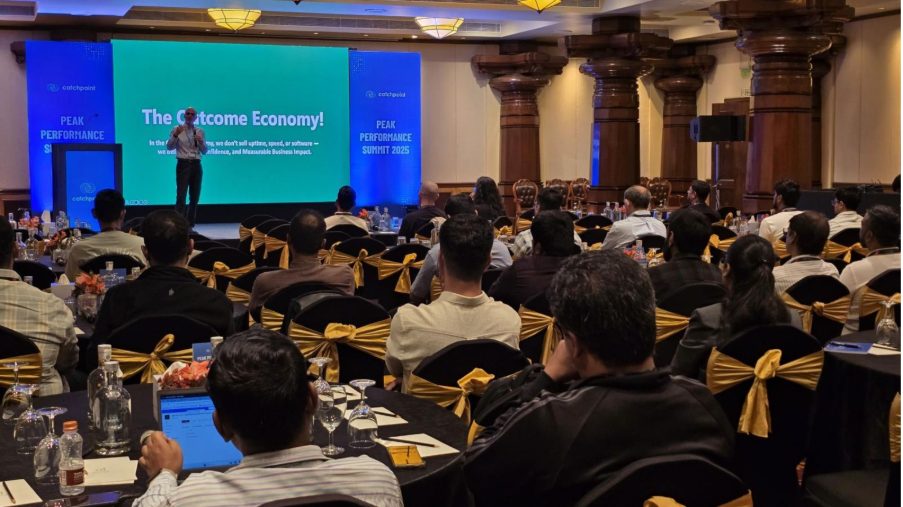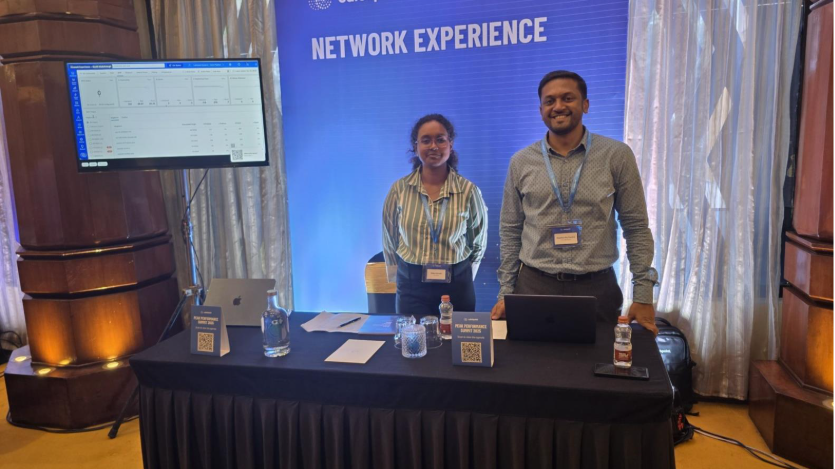Catchpoint Peak Performance Summit 2025: Redefining Observability for the Outcome Economy
We recently hosted our first-ever Peak Performance Summit in Bangalore, India, a one-day event focused on how value-based observability drives digital business outcomes.
The summit brought together customers, partners, and technology leaders to share real-world experiences, live demos, and forward-looking ideas. The message running through every session was clear: performance isn’t just about speed. It’s about measurable business results.
A new way to think about digital reliability
We kicked off the day with a keynote from Mehdi Daoudi, Catchpoint CEO, titled “The Outcome Economy.”

Mehdi opened with a simple but powerful idea:
“In today’s digital-first economy, we don’t sell uptime, speed, or software. We deliver trust, confidence, and measurable business impact.”
That message set the tone for the sessions that followed. Observability is no longer just a technical tool. It’s becoming the foundation for customer experience, resilience, and growth.
Building reliable services with AI and partnerships

Coley Burke, SVP of Global Sales at Catchpoint, outlined our vision for building reliability through AI and collaboration.
“Our mission is simple: help you respond faster and reduce any impact on your customers or workforce. We believe in making life easier for users, and AI is going to play a big part in that transformation.”
Coley emphasized partnerships as key to that goal. By integrating customer tools, providing a 360° operational view, and harmonizing insights with AI, we’re helping teams see clearly and act confidently when performance issues arise.
AI Observability: a strategic imperative for the future
In a joint session, Catchpoint's Ankit Kumar, Sr Manager, Value Engineering, and Rahul Raj, Sr Performance Specialist, shared how we’re expanding our observability platform to meet the challenges of AI-driven applications. As enterprises embrace AI-driven applications, observability can’t just stop at traditional infrastructure. It needs to go deeper into understanding AI models, inference latency, and the complex web of ecosystem dependencies.
This is exactly where our strategy is headed. We’re enhancing our observability platform to provide end-to-end visibility across AI-powered application stacks. Our goal is to deliver end-to-end visibility across AI-powered stacks, ensuring trust, performance, and resilience in every digital interaction.
From networks to neural networks, Catchpoint is extending observability into the intelligence layer, helping organizations deliver faster, smarter, and more reliable AI experiences.
Customer perspectives: observability that delivers
A highlight of the day was our customer panel, Internet Performance Monitoring in Action, featuring Varun Nair, Head of Network Engineering at Flipkart, Praveen Singh, Director of Engineering – IT at Akamai, and Sergey Katsev, VP of Engineering at Catchpoint.
The discussion centered on the shift from reactive monitoring to predictive observability. Using data-driven insights, teams can now anticipate issues before they occur, improving uptime and user experience while reducing operational risk.
Sales and strategy conversations: observability as a business enabler
Beyond technical excellence, the summit fostered impactful conversations around sales strategy and customer value.
Business leaders shared how observability is increasingly driving commercial success, influencing both revenue protection and customer trust:
- Reliability as a sales advantage: Enterprises are differentiating themselves by guaranteeing consistent digital experiences.
- Faster ROI through visibility: Customers shared that Catchpoint’s insights directly reduce downtime costs and accelerate go-to-market velocity.
- Trust as currency: Observability is now central to how organizations demonstrate operational excellence and earn customer loyalty.
As one attendee put it:
“When your digital service becomes your storefront, performance isn’t optional. It’s your reputation.”
Industry trends and technical insights

Sessions led by Varun Nair and Praveen Singh explored trends shaping the future of observability, including:
- Hybrid SRE models balancing reliability and agility.
- Real User Monitoring (RUM) as a core strategy for proactive performance management.
In a separate talk, Sergey discussed Catchpoint and IBM NS1 integration and how intelligent traffic steering supports resilient, high-performing Internet infrastructure.

Experience in action: the Network Experience zone

Our Network Experience Zone, led by Sheldon Periere, gave participants hands-on time with Catchpoint’s monitoring capabilities. From last-mile diagnostics to backbone visibility, live demos showed how Catchpoint helps detect, analyze, and resolve issues before users are affected.
A celebration of collaboration

Beyond the technology, the Catchpoint Peak Performance Summit 2025 was all about connection and collaboration. It was inspiring to see customers and partners share how observability is driving trust, confidence, and real business impact in their organizations.
One participant summed it up perfectly:
“It’s always inspiring to be part of conversations that push the boundaries of innovation and shape the future of digital performance.”
The energy in the room reflected Catchpoint’s core purpose in helping organizations thrive in a world where digital performance is business-critical.
Thank you!
A huge thank you to everyone who made the event possible, including our customers, partners, and the Catchpoint team. The Peak Performance Summit 2025 was more than an event. It was a milestone. As we look ahead, our focus remains the same: helping you deliver trust, confidence, and measurable business impact through observability.
Take a product tour
Get hands-on with real use cases like CDN monitoring, workforce experience, API performance, and more.
Unlock access to our Guided Product Tour library.
Summary
The Catchpoint Peak Performance Summit 2025 highlighted how observability now drives real business outcomes, focusing on trust, speed, and operational reliability in digital environments.



